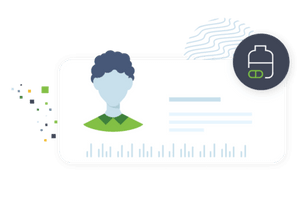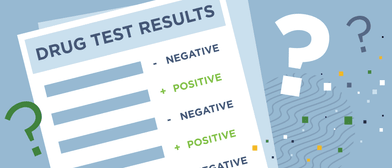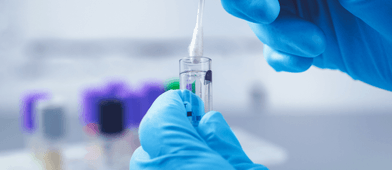Drug Testing
Employment Drug Testing & Screening
Improve workplace productivity and safety with a pre-employment drug screening program.
Trust & Safety
Why Is Employment Drug Testing Necessary?
Pre-employment and employment drug screening for the presence of prescription and illicit drugs helps employers maintain a safer, more productive workplace and:
- Decreases employee absenteeism and turnover
- Reduces risk of accidents and injuries
- Prevents drug use on the job
- Identifies drug use early by employees
- Lowers workers’ compensation rates
Search Options
GoodHire’s Employment Drug Testing Suite
GoodHire’s employer drug screening offerings are designed to meet your company policy and drug-free workplace obligations, while helping you maintain compliance with applicable regulations. Lab-based urine tests are available with multiple panel options. Lab results are verified by Medical Review Officers (MROs) for highest accuracy. GoodHire also offers DOT Drug Tests, which meet the strict guidelines required by the Federal Government.
* Quick Test is available, however it excludes Methaqualone (MQL) and tests for Methamphetamine in its place.
This is not a complete list of all drug tests. For additional drug testing capabilities, please contact Sales.
Compliance
What You Need To Know To Perform
Employment Drug Testing
Employers using a Consumer Reporting Agency (CRA), like GoodHire, to run background checks to assess candidates and employees must comply with the federal Fair Credit Reporting Act (FCRA) and various laws, agencies, and regulations that govern employment screening. When running a drug screening program, it’s also important to:
Create & Follow A Company Drug Testing Policy
Drug testing must be administered fairly and consistently. Candidates seeking employment can be tested as a condition of employment, but all incoming employees must be tested and no one may be singled out.
Check Your State’s Laws
Some states have imposed limitations on pre-employment drug testing. For example, California allows a drug test only after the applicant has received an offer of employment conditioned on passing the test. In other states, employers that drug test may be required to provide written notice or indicate in their job postings that testing is required. Check your state’s laws.
Be Proactive About Compliance
Always consult with your legal counsel if you have questions about drug tests as part of your employment screening program.
Learn More About Drug Testing For Employment (Frequently Asked Questions)
Employment drug testing can help employers screen candidates and existing employees for the presence of specific prescription and illicit drugs. Conducting pre-employment drug testing allows employers to make informed hiring decisions, ensure a safe and productive workplace, mitigate risk, and stay compliant with applicable drug-free workplace obligations, regulations, and drug testing laws. Here’s what you need to know about drug and alcohol testing.
What is pre-employment drug testing?
Pre-employment drug screening is the process of collecting and analyzing samples to determine if a candidate has recently used controlled substances or illicit drugs. For certain industries and positions, such as law enforcement and healthcare, drug testing laws and regulations may require employers to test all candidates. For other regulated occupations, such as commercial trucking, employers must screen candidates for drug use to comply with Department of Transportation (DOT) background check standards.
Get Fast, Accurate, Multi-Panel Drug Screenings
Get StartedPre-employment drug testing differs from employee drug testing, the process of screening for drug use by current employees. Employers may regularly test employees or adopt a random drug testing policy.
Employee and pre-employment drug screening for employees can lower the likelihood of drug use on the job, helping to reduce the risk of accidents and injuries and lower workers’ compensation rates. Drug testing may also decrease employee absenteeism and turnover. As a result, employers may choose to include drug screening in their background check processes even when drug testing laws don’t require you to do so.
How to conduct employment drug tests
Employers can choose to conduct drug tests by working directly with a lab or through a third-party provider. The logistics of drug testing can be challenging and time-consuming, as outlined below, which is why many employers choose to work with a qualified background check provider, like GoodHire, to streamline the process. The following is generally the process when conducting employment drug screening:
1. written policy
Employers should consider developing a written policy before conducting employment drug tests or purchasing testing supplies. This policy should comply with federal, state, and local drug testing laws and establish the actions that should be taken when testing reveals positive results that indicate drug use. Consult your legal counsel for best practices when drafting your organization’s policy.
2. disclosure
When screening for drug use with the help of a consumer reporting agency (CRA), like GoodHire, drug testing laws require you to inform the candidate of your intent to conduct a drug screening. The notice should appear as a standalone document, rather than as a disclosure within a job application.
3. consent
Before conducting an employment drug test, you must receive signed consent from the candidate. The form should explain what testing will occur and request consent to proceed. With automated workflows, GoodHire enables you to easily obtain this consent via email.
4. site selection
After obtaining the necessary consent, inform the candidate where the drug testing will occur or allow them to select a location nearby. GoodHire typically provides candidates with a list of local lab options for added convenience.
5. chain of custody form
A Chain of Custody form (CCF) is a document used to ensure the integrity and validity of drug test results. It tracks the handling and custody of a specimen from collection to final testing and reporting. Candidates receive this form after site selection and must bring it along with a government-issued photo ID to the testing location.
6. testing
During this step, a trained medical professional usually obtains a urine sample from the candidate or employee (though other specimen types are an option). The candidate will also be asked to complete and sign the Chain of Custody form. GoodHire advises candidates to bring any prescription medications they take to the testing site to be recorded, which can lower the likelihood of false positive results.
7. screening and verification
Once the specimen is collected, an initial screening is run by the lab to determine if any drugs are detected. If the initial screening shows indications of positive results (the presence of substances) an additional screening is performed with the results being reviewed by a Medical Review Officer (MRO). To support accuracy, all drug tests conducted through GoodHire are reviewed by an MRO.
8. results
Drug test results are typically ready for review within one to three days of the test. When you partner with GoodHire, the results appear in your dashboard and are made available for employees through the candidate portal. In the event of a positive result, the candidate or employee will automatically receive a notification.
9. next steps
Once you review the test results, be sure to follow your written policy to determine next steps. If you decide to disqualify a candidate or terminate an employee based on an employment drug test performed through a CRA, the Fair Credit Reporting Act (FCRA) requires you to follow the adverse action process.
Common employment drug testing methods
There are four common employment drug testing methods: mouth swab, urine, hair follicle, and blood specimens. With GoodHire, you can choose from a range of lab-based urine tests based on your organization’s drug testing policy.
Get Fast, Accurate, Multi-Panel Drug Screenings
Get StartedMouth swab (saliva) drug tests
A mouth swab drug test, also called oral fluid testing, involves collecting a sample of saliva with a swab stick equipped with an absorbent sponge or pad. When performed correctly, mouth swab tests are highly accurate. A study from one mouth swab testing system showed 100% accuracy for detecting cocaine, amphetamine, methamphetamine, and benzodiazepines and 97.5% accuracy for the detection of THC (marijuana). One drawback of the saliva pre-employment drug test is a relatively short detection window. In most cases, mouth swab tests can yield positive results when drug use occurs only up to 5-48 hours prior to specimen collection.
urine drug tests
The most common type of pre-employment drug test, urine drug tests, use a sample of urine to check for drug metabolites—substances created when the body breaks down drugs. Urine testing is non-invasive and involves a simple collection process. Depending on the substance, the frequency of usage, and other factors, urine drug tests can detect drug use that occurred up to four days prior to specimen collection. The biggest drawback to urine tests is they pose a risk of tampering. However, steps can be taken to lower the likelihood of this occurring.
hair follicle drug tests
In hair follicle drug tests, a scalp or body hair sample is analyzed to check for drug metabolites. Hair follicle testing allows for a longer look-back period than other testing methods. Scalp hair may show drug usage that occurred up to three months before testing, while body hair may yield positive results up to a year after drug usage. However, recent drug use may go undetected with this type of pre-employment drug test. Hair follicle testing can only screen for a limited number of substances and is more time-consuming and costly than other methods.
blood drug tests
While blood is the most reliable specimen to test for drug use, substances may only be detected in the bloodstream for a one to two days. For that reason, blood testing may better indicate whether someone is currently (or was very recently) under the influence. This type of test is the most invasive and is not commonly used for pre-employment drug testing.
What do pre-employment drug tests look for?
Pre-employment drug tests look for a variety of substances, including prescription and illegal drugs, such as marijuana, cocaine, amphetamines, and opioids. While there are many ways to test for drugs, lab-based urine tests are generally used by employers and may include different types of multi-panel testing such as 4-, 5-, 8-, and 10-panel testing options, as explained below.
How long does pre-employment drug screening take?
Pre-employment drug screening is generally a quick process. Employment drug screening typically starts with the collection of the candidate’s specimen, which can happen within a day or two, depending on lab appointment availability. After collection, the lab runs an initial screening for substances. If the screening shows indications of positive results, the lab performs an additional screening, and an MRO reviews the results. The results are then shared with the employer and the candidate, usually within three to five days. If additional testing is necessary, or if the MRO is unable to contact the candidate, results could take up to 10 business days.
Get Fast, Accurate, Multi-Panel Drug Screenings
Get Started4-panel drug tests
The most basic drug screening is a 4-panel drug test, which screens for four substances: amphetamines, cocaine, opiates, and phencyclidine. This type of drug testing is a good option for employers who only need to test for select, frequently abused drugs.
How far back do 4-panel drug tests go?
How far back 4-panel drug tests go varies based on how quickly a person’s body metabolizes substances, how heavily they used drugs in the past, and other factors. The substances that 4-panel drug testing screens for typically are detectable in urine for around two to four days, though amphetamines may have a shorter detection window, while phencyclidine may be detected for up to 30 days for chronic users.
What does a 4-panel drug screen test for?
A 4-panel drug screen tests for:
- Amphetamines
- Cocaine
- Opiates
- Phencyclidine
5-panel drug tests
Able to detect five commonly abused drugs, 5-panel drug tests are the screening tests of choice for many employers. In most cases, this type of drug test also fulfills DOT drug testing requirements.
How far back do 5-panel drug tests go?
How far back 5-panel drug tests go depends on how rapidly a person’s body metabolizes drugs, how frequently they use illicit substances, and other factors. Substances included in 5-panel drug testing are generally detectable for two to four days after usage occurs, but some may show up on a drug test for longer based on usage.
What does a 5-panel drug screen test for?
A 5-panel drug screen tests for:
- Amphetamines
- Cocaine
- Marijuana (THC)
- Opiates
- Phencyclidine (PCP)
8-panel + MQL drug tests
For employers that require a more comprehensive approach to drug testing, 8-panel + MQL drug tests may be a good solution. With 8-panel drug testing, a candidate is screened for eight commonly abused substances. Often, 8-panel tests also include a screening for methaqualone (MQL), a type of sedative sometimes referred to as quaalude.
How far back do 8-panel drug tests go?
How far back 8-panel drug tests go depends on how frequently a person uses a drug, how quickly their body metabolizes substances, and other factors. Some substances, such as amphetamines, cocaine, and opiates, may only be detected for several days while others are detectable for a week or longer after usage.
What does an 8-panel drug screen test for?
An 8-panel drug screen tests for:
- Amphetamines
- Barbiturates
- Benzodiazepines
- Cocaine
- Methadone
- Opiates
- Phencyclidine (PCP)
- Propoxyphene
An 8-panel + MQL drug test screens for all of the above substances, plus methaqualone.
10-panel drug tests
As the most comprehensive drug screening option, 10-panel drug tests are a common choice for employers looking to comply with internal policies and federal, state, and local drug testing laws.
How far back do 10-panel drug tests go?
How far back 10-panel drug tests go varies based on frequency of drug usage, individual rates of drug metabolism, and other factors. The detection window for most substances included in 10-panel drug testing is one to three days. However, some substances drugs may be detectable for longer based on chronic usage.
What does a 10-panel drug screen test for?
A 10-panel drug screen tests for:
- Amphetamines
- Barbiturates
- Benzodiazepines
- Cocaine
- Marijuana (THC)
- Methadone
- Methaqualone
- Opiates
- Phencyclidine (PCP)
- Propoxyphene
Order employment drug tests with GoodHire
Pre-employment drug testing may be an important part of your background check process to help maintain a safer, more productive workplace. Companies that choose to work with a qualified background check provider, like GoodHire, can benefit from faster, more accurate results.
GoodHire offers 100+ background screening options, including 4-, 5-, 8- and 10-panel drug tests. Our drug screenings can help employers meet company policy and drug-free workplace obligations while complying with federal, state, and local regulations. Plus, our user-friendly platform provides easy scheduling and streamlined reporting. Get started with GoodHire today.
Get Fast, Accurate, Multi-Panel Drug Screenings
Get StartedThe resources provided here are for educational purposes only and do not constitute legal advice. We advise you to consult your own counsel if you have legal questions related to your specific practices and compliance with applicable laws.





